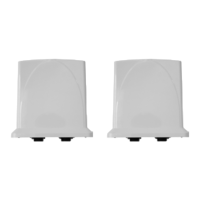Tsunami QB-8100 Series (100 Mbps/5 Mbps Models) Installation and Management Guide 195
To reset to factory default settings, press and hold the RELOAD button on the side of the unit’s PoE injector power supply for
5 seconds. The current configuration is deleted from the unit and the unit reboots, with factory defaults.
CAUTION: It you hold the RELOAD button for longer than 10 seconds, you may go into Forced Reload mode, which
erases the unit’s embedded software.
8.4.13 Forced Reload
With Forced Reload, you bring the unit into bootloader mode by erasing the embedded software. Use this procedure only as
a last resort if the unit does not boot and the procedure did not help.
CAUTION: By completing this procedure, the embedded software in the unit will be erased. You will need to reload the
software before the unit is operational.
To do a forced reload
1. Reset the unit by resetting the power plug of PoE injector.
2. Press and hold the RELOAD button which is located on the PoE injector for about 20 seconds. The unit deletes the
current firmware.
3. Unit will try to load the required firmware using the default factory configuration parameters. If this fails, then it will
enter either CLI mode or ScanTool mode as per the user’s choice, with a message on the serial console “Starting
ScanTool interface, press any key to enter CLI 5”. Follow one of the procedures below to load a new firmware to the
unit:
• Download a New Image Using ScanTool
• Download a New Image Using the Bootloader CLI
Because the CLI option requires a physical connection to the unit’s serial port, Proxim recommends the ScanTool Option.
8.4.14 VLAN Operation Issues
The correct VLAN configuration can be verified by “pinging” both wired and wireless hosts from both sides of the device and
the network switch. Traffic can be “sniffed” on the wired (Ethernet), if configured. Bridge frames generated by wireless
clients and viewed on one of the backbones should contain IEEE 802.1Q compliant VLAN headers or tags. The VLAN ID in the
headers should correspond to one of the VLAN User IDs configured for the unit.
The correct VLAN assignment can be verified by pinging:
• The unit to ensure connectivity
• The switch to ensure VLAN properties This should be checking not pinging
• Hosts past the switch to confirm the switch is functional
Ultimately, traffic can be “sniffed” on the Ethernet interface using third-party packages. Most problems can be avoided by
ensuring that 802.1Q compliant VLAN tags containing the proper VLAN ID have been inserted in the bridged frames. The
VLAN ID in the header should correspond to the assigned VLAN.
What if network traffic is being directed to a nonexistent host?
• All sessions are disconnected, traffic is lost, and a manual override is necessary.
• Workaround: You can configure the switch to mimic the nonexistent host.
I have just configured the Management ID and now I can't manage the device.
• Check to ensure your password is correct. If your password is incorrect or all inbound packets do NOT have the correct
tag, then a Forced Reload is necessary.
CAUTION: The Forced Reload procedure disconnects all users and resets all values to factory defaults.

